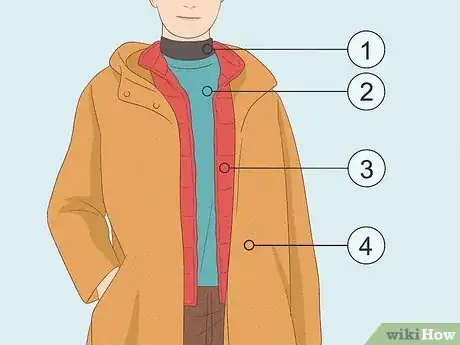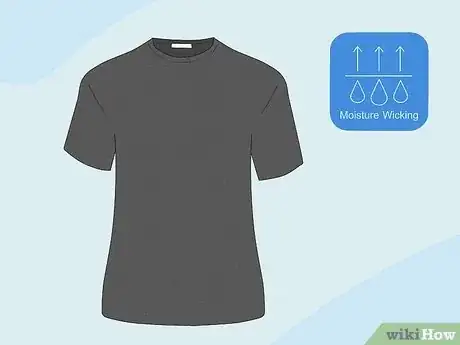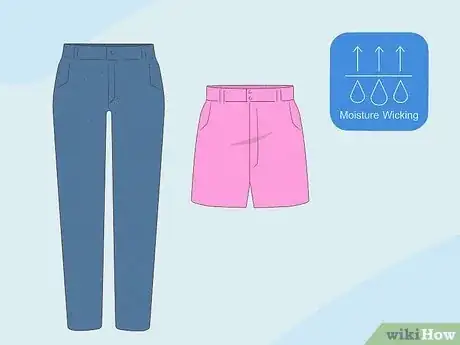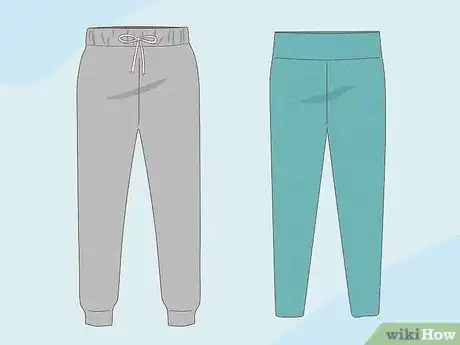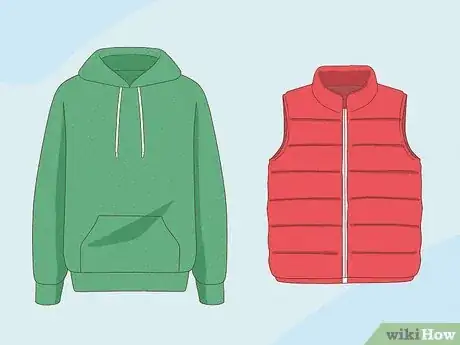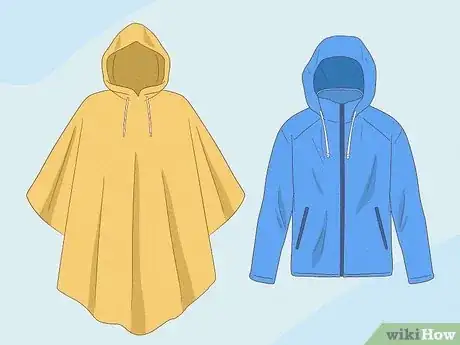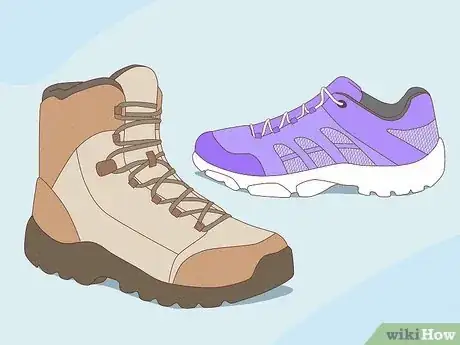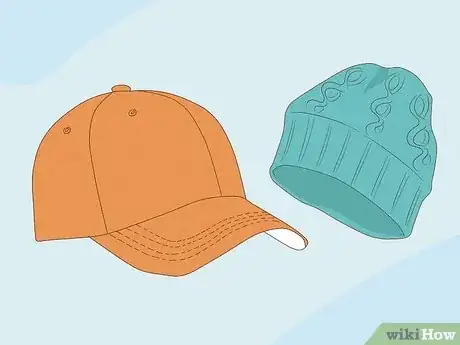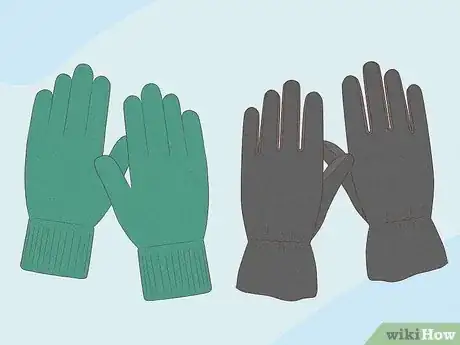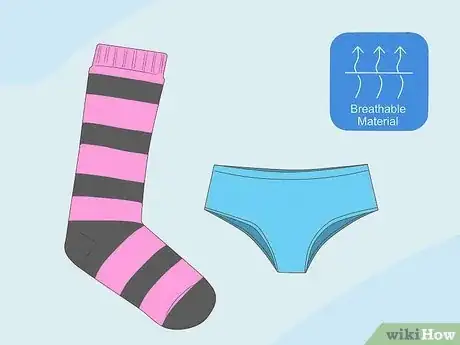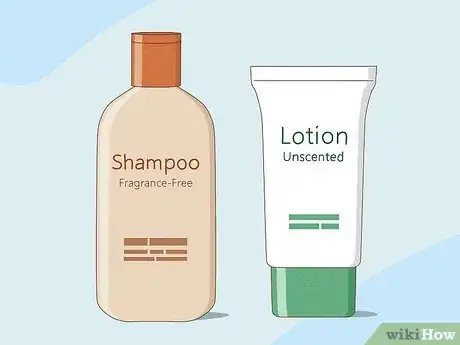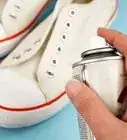This article was written by Britt Edelen and by wikiHow staff writer, Aly Rusciano. Britt Edelen comes to wikiHow after graduating in 2019 from Brown University, where he studied English and German literature and philosophy. While at Brown he contributed frequently to campus publications and worked in the university’s Writing Center. More recently, he has had several articles published in various journals devoted to literary criticism. During his time at wikiHow, Britt supervised and collaborated with writers and editors to continue producing high-quality content and promote wikiHow’s mission of enabling everyone to learn anything.
There are 17 references cited in this article, which can be found at the bottom of the page.
This article has been viewed 2,715 times.
Your camping trip is quickly approaching, and you couldn’t be more excited—but what do you wear? With fluctuating weather forecasts and the unpredictability of the great outdoors, which outfits could prepare you for everything? Fear not because we’ve got everything you need to know about the best clothing for camping! From fabric types to layering up, we’ll cover it it all, so keep reading to learn what to and not to pack for your camping trip.
This article is based on an interview with our BA in English Literature, Britt Edelen. Check out the full interview here.
Things You Should Know
- Wear synthetic clothing items that are quick-drying and moisture-wicking no matter what season you’re camping.
- Pack layers so you can add or remove items to stay comfortable no matter the weather.
- Opt for wool and fleece garments in colder months or thin synthetic materials for warmer months.
- When it comes to camping clothes, always go for comfort and practicality—nature is its own type of red carpet!
Steps
Layers
-
No matter the season, pack clothes that you can layer easily. The weather can fluctuate while you’re camping, and it’s always better to be prepare than not prepared at all! Aim to wear at least 3 layers of clothing in the fall and winter, and pack extra light layers in the spring and summer. Follow these layering basics to create the perfect camping outfit:[1] X Research source
- The base layer or the first layer consists of synthetic tops and pants.
- The mid layer or second layer is for fleece or long sleeve tops.
- The insulating layer keeps you warm and can include a sweatshirt, winter jacket, or vest.
- The outer layer or third layer protects you from the elements, such as a parka or rain jacket.
Moisture-wicking tops
-
A quick-drying shirt will help you stay cool and layer up. You won’t be sorry about packing a moisture-wicking shirt, no matter the weather. This light-weight fabric is super breathable and dries quickly, making it perfect for any active activity—including camping! Wear a t-shirt or tank top on its own in warmer months, or layer up with a long sleeve shirt and jacket during the colder seasons.[2] X Research source
- Try to avoid wearing cotton shirts while camping, as the fabric can absorb sweat and leave you feeling sticky and stinky.[3] X Research source
- Opt for a shirt with sun protection in the winter and summer to help keep your skin from burning.[4] X Research source
- Consider wearing a thermal shirt if you’re camping in the fall or winter for extra warmth.[5] X Research source
Moisture-wicking pants or shorts
-
Clothes that repel water work best in hot and cold weather. Camping sure is fun but let’s be honest; it can get rather sweaty. Wearing moisture-wicking pants or shorts will help you stay cool when pitching the tent or going for a hike in any season.[6] X Research source
- Try to avoid wearing jeans, as the thick material can trap sweat and cause chafing—ouch![7] X Research source
- Give cargo pants a try. Store extra snacks in your pockets or collect rocks on your hike—the possibilities of pockets are endless.
Sweatpants or leggings
-
Comfy bottoms can help you move freely while camping. In the warmer months, opt for nylon sweatpants or moisture-wicking yoga pants. In the colder months, try fleece sweatpants or layering leggings underneath. You can wear these practicable clothes in the woods without sacrificing style or comfort.[8] X Research source
- Fleece-lined leggings can be a great choice when camping in the winter. They can cause you to sweat more, so consider wearing them to bed or when sitting around the fire.
Sweatshirt, hoodie, or vest
-
An extra layer can keep you warm in colder temperatures. The weather can be unpredictable when you’re camping—that’s part of the fun—but it’s always better to be prepared. If you’re camping in the winter, always pack a fleece sweatshirt, hoodie, or insulating vest. If you’re camping while it’s warmer out, pack one anyway. Temperatures can drop at night, and these items can help you stay warm while roasting marshmallows.[9] X Research source
- Consider packing a sweatshirt with a hood in case it’s windy, so you can wander the campsite and keep your ears warm.
Rain jacket or parka
-
Water-resistant clothes help you stay dry on rainy days. If the forecast predicts rain during your camping trip, consider bringing a rain jacket, parka, or poncho along. These water-resistant coverings can help you enjoy the great outdoors in the rain, and all you have to do is throw them on over your current layers.[10] X Research source
Hiking boots or waterproof sneakers
-
Shoes with good traction that resist water help you in all terrains. Between mud, rain, or dew, keeping your toes protected and dry is a must. Opt for a boot or sneaker specifically made for hiking or outdoor use, as these have a non-slip grip that makes it easier to climb and walk on uneven ground.[11] X Research source
- Opt for a pair of hiking boots with a thick sole, good arch support, and comfortable yet secure fit.
- Bring some rain boots if it’s going to be extra rainy, so you can continue to explore the campsite, puddles and all.
- Pack a pair of water shoes if you’re planning on swimming. Some lake and river bottoms can be rocky, and water shoes help protect your feet while you swim.
- Avoid bringing flip-flops along, even in the summertime, as they leave your feet unprotected and could get stuck on the terrain.
Baseball hat or beanie
-
Hats keep the sun out of your eyes and your head warm. When camping in the warmer months, consider bringing a baseball hat or visor along with you. If it’s a bit colder out, opt for a warm winter hat like a beanie instead.[12] X Research source
- Try wearing a baseball hat and beanie if it’s sunny and cold.
- If hats aren’t your thing, trade the baseball cap for a pair of sunglasses and the beanie for ear muffs or a head wrap.
Gloves
-
Two pairs of gloves help keep your hands warm and dry in the winter. If it’s going to be cold or snowy on your camping trip, make sure to bring gloves with you. Wool gloves are the perfect base layer for snowy weather or somewhat chilly temperatures. For extra warmth, put wind proof gloves over the wool glove. This will help your hands stay toasty and dry.[13] X Research source
- Consider packing hand warmers and lotion along with your gloves. Hand warmers can easily slide in your jacket pocket for quick warmth, and lotion will prevent dry, cracked skin.[14] X Research source
Breathable undergarments
-
Light-weight underwear and socks will help you stay dry. No matter what your camping trip entails, you’re bound to sweat a bit. Wearing synthetic underwear and socks that are breathable and quick-drying will help you stay cool and happy. Plus, quick-drying socks help you trudge through puddles without a second thought.[15] X Research source
- Sometimes, it’s better to splurge on more expensive socks if they’re durable. The last thing you want is to get a hole in your sock mid-hike!
- Wear a style of underwear that’s the most comfortable for you. As long as it’s breathable and moisture-wicking, it’ll do the trick.
- Consider packing long wool socks if you’re camping in the fall or winter. These help your feet and calves stay warm.[16] X Research source
Fragrance-free hygiene products
-
Strong fragrances can attract wildlife. Leave your perfumes and body sprays at home. Instead, opt for fragrance-free body care products.[17] X Research source This simple trick can help keep bugs and any other curious animals (including bears) away from your campsite.[18] X Trustworthy Source US National Park Service Agency responsible for the maintenance and promotion of national parks and monuments Go to source
You Might Also Like
 How to Stop Crickets from Chirping Outside or Inside Your Home
How to Stop Crickets from Chirping Outside or Inside Your Home













References
- ↑ https://youtu.be/XHRp3SeSEe8?t=86
- ↑ https://www.advnture.com/features/-moisture-wicking-material
- ↑ https://youtu.be/pmEv49GRK8A?t=178
- ↑ https://youtu.be/Rt33OIN_sVs?t=92
- ↑ https://youtu.be/41UGUr5cv64?t=601
- ↑ https://youtu.be/XHRp3SeSEe8?t=136
- ↑ https://youtu.be/pmEv49GRK8A?t=178
- ↑ https://youtu.be/XHRp3SeSEe8?t=265
- ↑ https://youtu.be/XHRp3SeSEe8?t=176
- ↑ https://youtu.be/XHRp3SeSEe8?t=203
- ↑ https://www.alaska.org/advice/what-to-wear-hiking
- ↑ https://www.alaska.org/advice/what-to-wear-hiking
- ↑ https://youtu.be/XHRp3SeSEe8?t=296
- ↑ https://youtu.be/JQK-h1D6RjE?t=303
- ↑ https://youtu.be/5zX_PIUpCh0?t=193
- ↑ https://youtu.be/pmEv49GRK8A?t=203
- ↑ https://koa.com/blog/how-to-keep-bugs-away-while-camping-keep-insects-out-of-your-tent/
- ↑ https://www.nps.gov/yell/learn/nature/grizzlybear-menstrual-odor.htm
- ↑ https://youtu.be/eFWTLXE6kV0?t=438
About This Article

